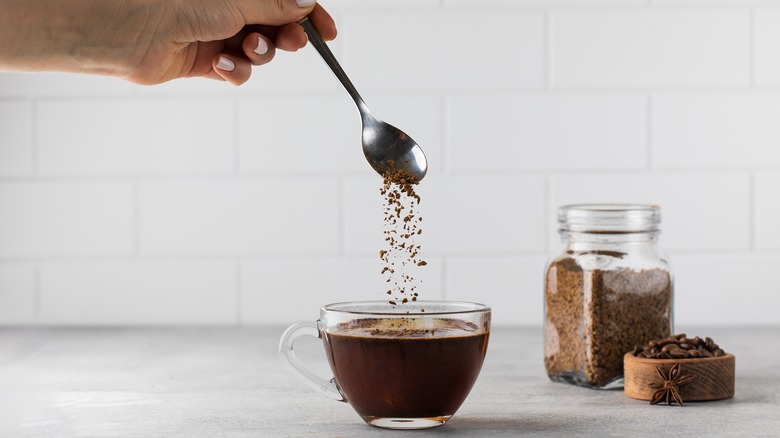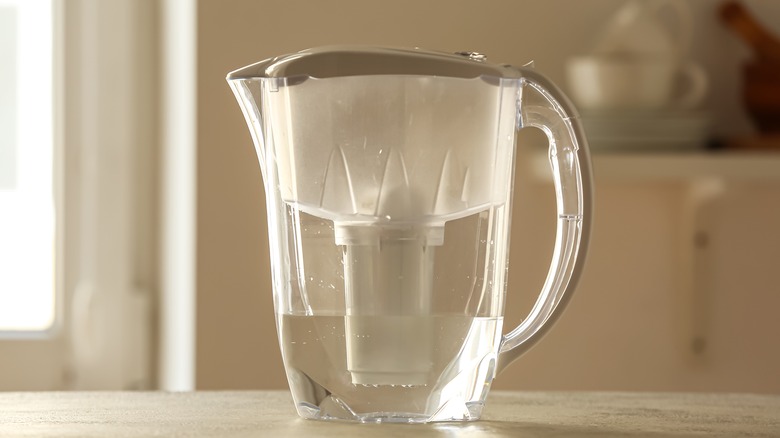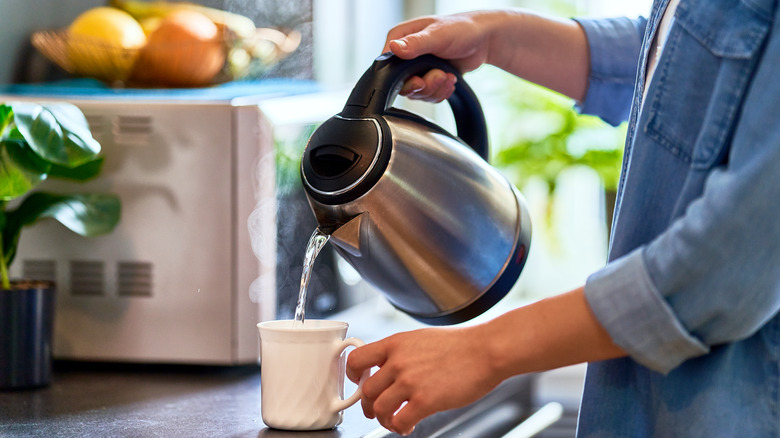Your Instant Coffee Will Taste Café-Made With One Simple Swap
We all love a fancy coffee shop drink. A frothy Americano, the perfectly creamy oat milk latte in the perfect pale hue, a whipped cream-adorned flavored concoction with an extra shot ... Americans generally can't get enough of the dressed-up drinks. But sometimes, whether your palate prefers a more stripped-down option where you can actually taste the coffee, or because convenience is king, or it's just what you have on hand, instant coffee not only gets the job done but hits the spot.
And while it's generally not heralded as the end-all-be-all for delicious fresh coffee flavor, there are ways to make it that much more appealing, so don't listen to the instant coffee haters. Done right, it can be delicious. The biggest game changer is the water you use for home-brewed coffee — after all, that's what's making up most of your cup. By using filtered, or high-quality water, you control the taste of your cup and make sure it tastes coffee-shop worthy, not bitter or acidic, which can occur if you use water straight out of the kitchen sink.
In a world of pricey at-home espresso machines and frothy, foamy, sugary add-ins, sometimes a simple spoonful of instant coffee grounds is refreshing, and it's an easy way to get your caffeine fix without fuss. It's a great option to take traveling with you since it doesn't require a machine or your daily coffee method.
Choose filtered water for the smoothest cup
You're not alone if you've ever snubbed your nose at a bag of instant coffee, skeptical that it could taste as good as an artisanal cup of drip or perfect pour-over coffee. For the discerning palate or the true coffee aficionado, instant coffee may not ever be a perfect dupe for those methods. The taste of instant coffee should be pleasant, and maybe even just as enjoyable as whole-bean java.
To achieve this, the most important tip is to choose your water wisely. If you get city tap water, you may want to reach for filtered water instead — be it from a gallon or your at-home purifier, to reduce plastic waste. But filtering water doesn't necessarily remove all contaminants, so always make sure your water source is clean and safe. This can significantly clean your coffee up, removing invisible-to-the-naked-eye substances that can alter the taste. Minerals in tap water and well water, like aluminum and copper to name a few, can impart a metallic or slightly acidic flavor to the water. When this comes into contact with instant coffee, the result can be a harsh or acidic-tasting brew. Traveling and don't have access to a kettle of fresh water? Ask your hotel or even a barista at the airport for a cup of hot water — then just stir in your coffee packet and you're good to go.
Use hot water always, but never from the microwave
Instant coffee is different from whole beans or grounds because it's been further processed into a ready-to-dissolve and drink substance. The process involves making a regularly brewed cup of coffee, which is condensed into a thick liquid and then turned into a powder via a spray-drying or freeze-drying process. The result is that instant coffee can simply be stirred into hot water and dissolved in moments.
In addition to using filtered water without high mineral content, you'll need that water hot. But always use a kettle. And while hot water is best, pouring still-boiling water into your mug can make the instant coffee turn scorched and bitter — not what anyone wants to wake up to. This isn't a job for the microwave, since you can't control the temperature and water can easily become super hot. The sweet spot is around 190 to 205 degrees Fahrenheit, which means it's not yet boiling. After you pour and simply stir, it's time to enjoy with your favorite creamer or add-in — no wait time necessary! And we'll raise a mug to that.


